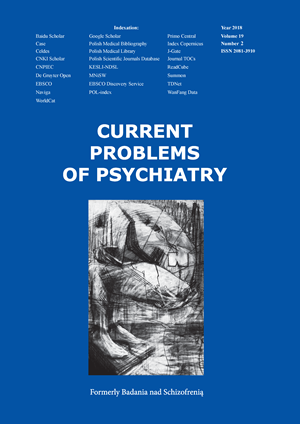Phantom limb phenomenon as an example of body image distortion
DOI:
https://doi.org/10.1515/cpp-2017-0013Słowa kluczowe:
zjawisko kończyny fantomowej, ból fantomowy, obraz ciała, pamięć somatosensorycznaAbstrakt
Wprowadzenie: Na obraz ciała składa się percepcja własnego ciała, jego mentalna reprezentacja oraz stosunek emocjonalny wobec niego [1]. Celem badania była analiza bólu fantomowego i nie związanych z bólem doznań fantomowych jako rezultatu utraty kończyny oraz próba ich wyjaśnienia w kategoriach zniekształcenia obrazu ciała.
Materiał i metoda: W badaniu 22 osób po amputacjach kończyn (7 kobiet i 15 mężczyzn w wieku od 43 do 76 lat, M = 61, SD = 11.3) zastosowano trzy narzędzia: (1) wywiad kliniczny; (2) Kwestionariusz Doświadczania Własnego Ciała Przez Pacjenta Po Amputacji Kończyny; (3) zmodyfikowaną wersję Arkusza Doznań Bólowych, opartego na The McGill Pain Questionnaire.
Wyniki: Ból fantomowy wystąpił u 59% uczestników badania, natomiast różnorodne doznania fantomowe nie związane z bólem były relacjonowane przez 77% badanych po amputacjach kończyn. Stwierdzono statystycznie istotny związek między bólem fantomowym a doznaniami fantomowymi nie związanymi z bólem w grupie osób doświadczających zjawiska kończyny fantomowej w momencie badania.
Wnioski: Zniekształcenie obrazu ciała w postaci bólu fantomowego i nie związanych z bólem doznań fantomowych jest częstym doświadczeniem osób po utracie kończyny. Sugerujemy, że kończyna fantomowa jest formą nieaktualnego lub nieadekwatnego obrazu ciała, wynikającego z aktywności mózgu, który stara się zachować rodzaj status quo. Współwystępowanie doznań fantomowych nie związanych z bólem i bólu fantomowego wskazuje, że obie te formy doznań poamputacyjnych mają wspólne podłoże neuronalne. Wyniki sugerują, że istnieje pamięć somatosensoryczna, która przejawia się w podobieństwie doznań przed- i poamputacyjnych.
Bibliografia
1. Gallagher S, Meltzoff AN. The earliest sense of self and others: Merleau-Ponty and recent developmental studies. Philos. Psychol. 1996;9:213-36.
2. Kułakowska Z. Wczesne uszkodzenie dojrzewającego mózgu. Od neurofizjologii do rehabilitacji. Lublin: Wydawnictwo Folium; 2003.
3. Gallagher S, Cole J. Body image and body schema in a deafferented subject. J. Mind Behav. 1995;16:369-89.
4. Giummarra MJ, Gibson SJ, Georgiou-Karistianis N, Bradshaw JL. Mechanisms underlying embodiment, disembodiment and loss of embodiment. Neurosci. Biobehav. Rev. 2008;32:143-60.
5. Jeannerod M. Visual and action cues contribute to the self-other distinction. Nat. Neurosci. 2004;7:422-3.
6. Churchland PS. Self-representation in nervous systems. Science. 2002;296:308-10.
7. Sirigu A, Grafman J, Bressler K, Sunderland T. Multiple representations contribute to body knowledge processing. Evidence from a case of autotopagnosia. Brain J. Neurol. 1991;114 (Pt 1B):629-42.
8. Schwoebel J, Coslett HB. Evidence for multiple, distinct representations of the human body. J. Cogn. Neurosci. 2005;17:543-53.
9. Maravita A, Iriki A. Tools for the body (schema). Trends Cogn. Sci. 2004;8:79-86.
10. Gallagher S. Body schema and intentionality. In: Bermúdez JL, Eilan N, Marcel A, editors. Body Self. Cambridge MA: The MIT Press; 2001. p. 225-44.
11. Gallgher S. How the body shapes the mind. New York: Oxford University Press; 2005.
12. Cole J, Paillard J. Living without touch and peripheral information about body position and movement: Studies with deafferented subjects. In: Bermúdez JL, Eilan N, Marcel A, editors. Body Self. Cambridge MA: The MIT Press; 2001. p. 245-66.
13. Ehde DM, Czerniecki JM, Smith DG, Campbell KM, Edwards WT, Jensen MP, et al. Chronic phantom sensations, phantom pain, residual limb pain, and other regional pain after lower limb amputation. Arch. Phys. Med. Rehabil. 2000;81:1039-44.
14. Goldenberg G. Disorders of body perception. In: Farah MJ, Feinberg TE, editors. Patient-Based Approaches Cogn. Neurosci. Cambridge MA: The MIT Press; 2000. p. 107-14.
15. Hill A. Phantom limb pain: a review of the literature on attributes and potential mechanisms. J. Pain Symptom Manage. 1999;17:125-42.
16. Kooijman CM, Dijkstra PU, Geertzen JH, Elzinga A, van der Schans CP. Phantom pain and phantom sensations in upper limb amputees: an epidemiological study. Pain. 2000;87:33-41.
17. Nikolajsen L, Jensen TS. Phantom limb pain. Br. J. Anaesth. 2001;87:107-16.
18. Wolff A, Vanduynhoven E, van Kleef M, Huygen F, Pope JE, Mekhail N. 21. Phantom Pain. Pain Pract. 2011;11:403-13.
19. Bosmans JC, Geertzen JHB, Post WJ, van der Schans CP, Dijkstra PU. Factors associated with phantom limb pain: a 31/2-year pro-spective study. Clin. Rehabil. 2010;24:444-53.
20. Flor H. Phantomlimb pain: characteristics, causes, and treatment. Lancet Neurol. 2002;1:182-9.
21. Flor H. Phantom limb pain. In: Ramachandran VS, editor. Encycl. Hum. Brain. New York: Elsevier Science; 2002. p. 83141.
22. Melzack R. From the gate to the neuromatrix. Pain. 1999;Suppl 6:S1216.
23. Schott GD. Delayed onset and resolution of pain: some observations and implications. Brain J. Neurol. 2001;124:1067-76.
24. Whyte AS, Niven CA. Psychological distress in amputees with phantom limb pain. J. Pain Symptom Manage. 2001;22:938-46.
25. Whyte AS, Niven CA. Variation in phantom limb pain: results of a diary study. J. Pain Symptom Manage. 2001;22:947-53.
26. Montoya P, Larbig W, Grulke N, Flor H, Taub E, Birbaumer N. The relationship of phantom limb pain to other phantom limb phenomena in upper extremity amputees. Pain. 1997;72:87-93.
27. Hsu E, Cohen SP. Postamputation pain: epidemiology, mechanisms, and treatment. J. Pain Res. 2013;6:121-36.
28. Ramachandran VS, Levi L, Stone L, Rogers-Ramachandran D, McKinney R, Stalcup M, et al. Illusions of body image: What they reveal about human nature. In: Llinás R, Churchalnd PS, editors. Mind-Brain Contin. Sens. Process. Cambridge MA: The MIT Press; 1996. p. 29-61.
29. Giummarra MJ, Georgiou-Karistianis N, Nicholls MER, Gibson SJ, Chou M, Bradshaw JL. Corporeal awareness and proprioceptive sense of the phantom. Br. J. Psychol. 2010;101:791-808.
30. Gontarczyk M. Doświadczanie własnego ciała przez pacjentów po amputacjach kończyn [Unpublished master’s thesis]. [Lublin]: Maria Curie-Sklodowska University; 2006.
31. Dobrogowski J, Kuś M, Sedlak K, Wordliczek J. Ból i jego leczenie. Warszawa: Springer PWN; 1996.
32. Melzack R. The McGill Pain Questionnaire: major properties and scoring methods. Pain. 1975;1:277-99.
33. Flor H, Nikolajsen L, Staehelin Jensen T. Phantom limb pain: a case of maladaptive CNS plasticity? Nat. Rev. Neurosci. 2006;7:873-81.
34. Li S, Melton DH, Li S. Tactile, thermal, and electrical thresholds in patients with and without phantom limb pain after traumatic lower limb amputation. J. Pain Res. 2015;8:169-74.
Pobrania
Opublikowane
Numer
Dział
Licencja
Prawa autorskie (c) 2017 Autorzy

Praca jest udostępniana na licencji Creative Commons Attribution-NonCommercial-NoDerivatives 3.0 Unported License.


